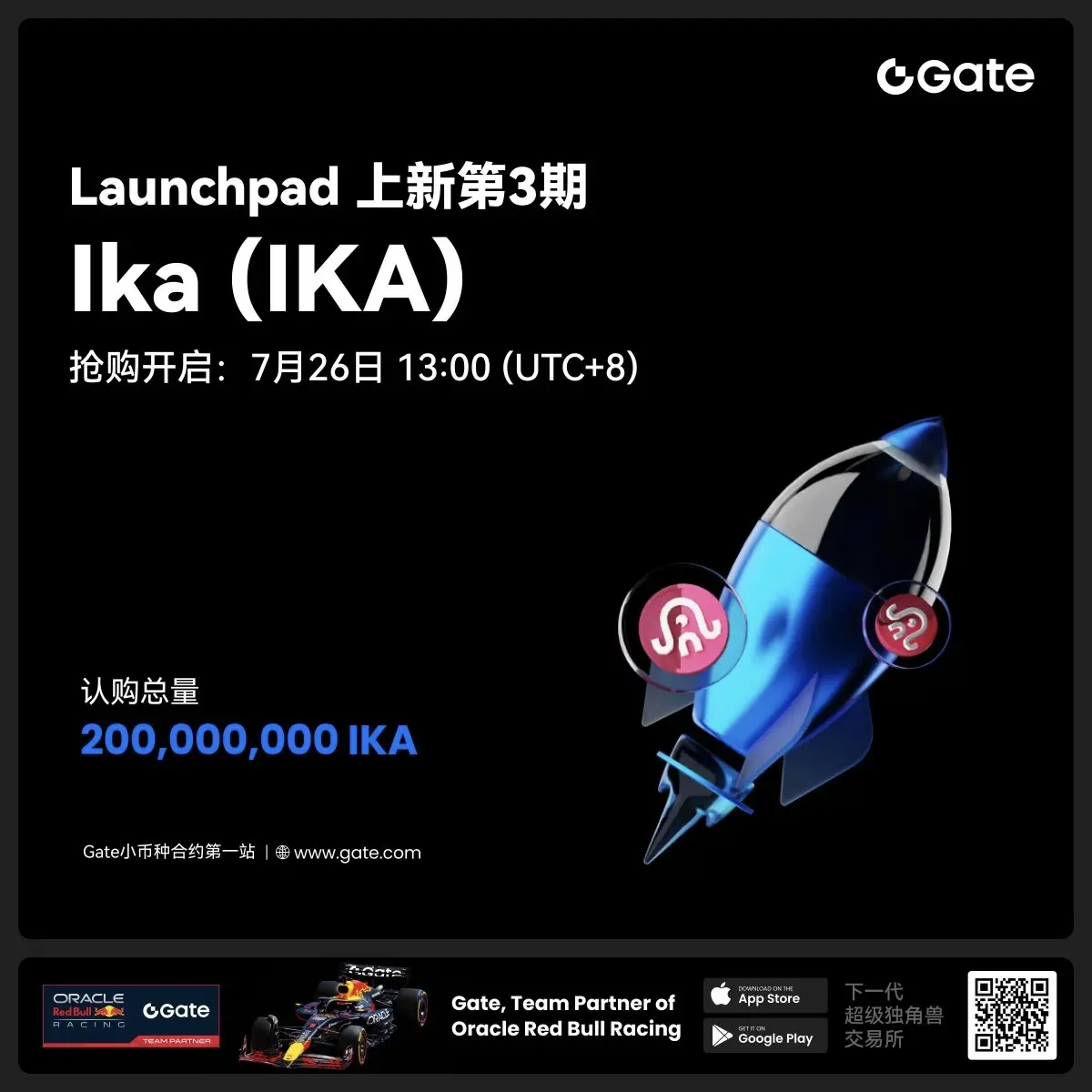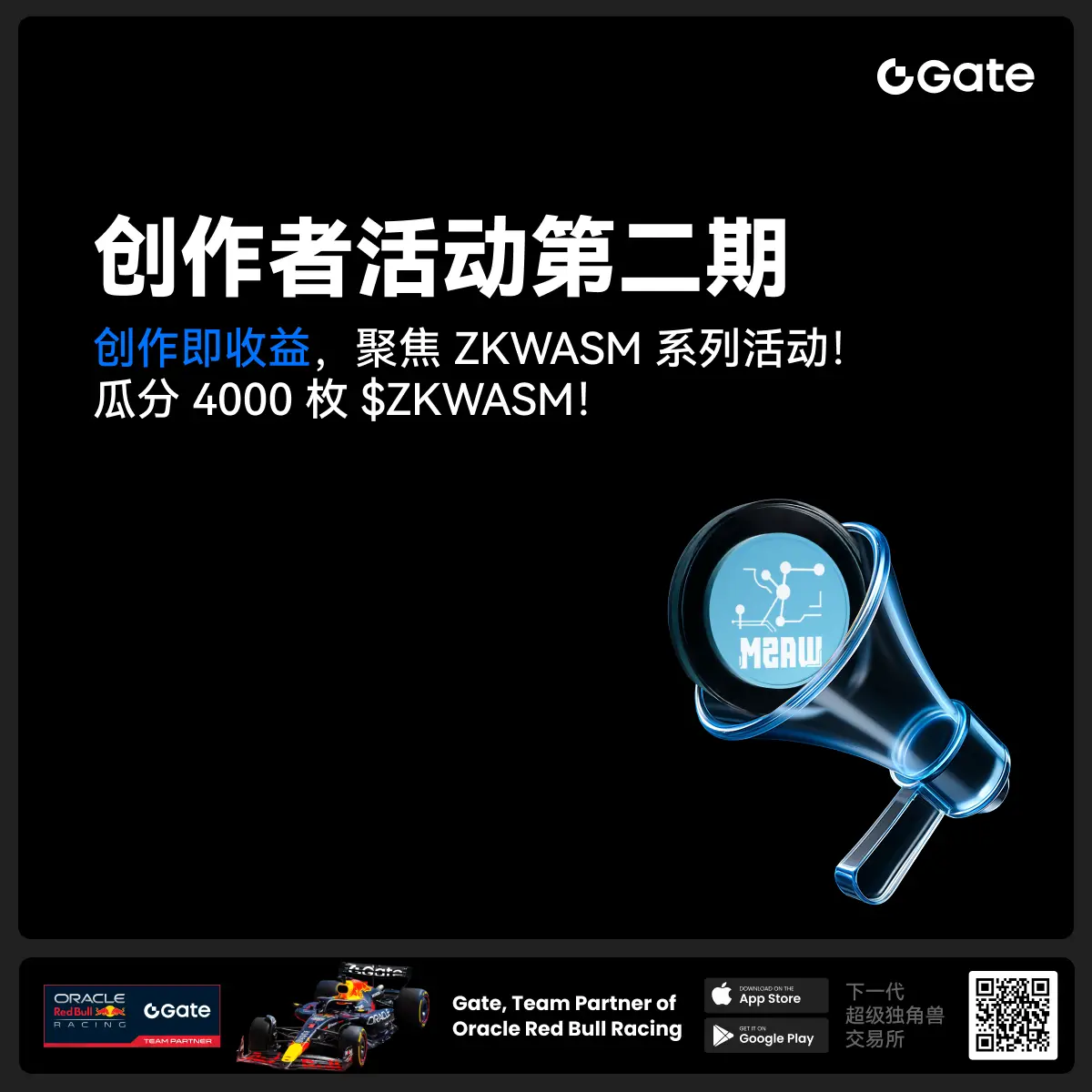- 話題1/3
47055 熱度
4087 熱度
2984 熱度
344 熱度
466 熱度
- 置頂
- 🎉 Gate 廣場 IKA Launchpad 發帖活動來襲!🎉
Gate Launchpad 認購 IKA 最後24小時!曬出你的認購體驗,和大家一起分享,每個人都有機會瓜分 $200 獎池!
🎁 4位幸運分享者*$50合約體驗券每人!
🧐 如何參與:
1.在廣場發帖,帶上 #GateLaunchpad上线IKA# 標籤
2.曬出你的認購截圖 或 分享你的獨特認購小竅門/心得或趣事
3.保證帖子大於50字,內容有趣有料,原創,集齊至少3個互動(點讚/評論/轉發)
IKA認購連結:https://www.gate.com/launchpad/2336?downgarde=true
活動時間:7月28日 12:00 - 7月30日 24:00 (UTC+8)
趕快加入,分享你的精彩時刻,你就是下一個幸運兒!
- 📢 Gate廣場 #创作者活动第二期# 正式開啓!
聚焦 ZKWASM 系列活動,分享你的觀點,瓜分 4,000 枚 $ZKWASM!
ZKWASM 作爲 zk 公鏈先鋒,正在 Gate 平台重磅推廣!
三大活動聯動上線:Launchpool 認購、CandyDrop 空投、Alpha 專屬交易——不要錯過!
🎨 活動一:發布廣場貼文,贏內容獎勵
📅 時間:7月25日 22:00 - 7月29日 22:00(UTC+8)
📌 參與方式:
- 在 Gate 廣場發布與 ZKWASM 或其三大活動相關的原創內容(不少於 100 字)
- 添加標籤: #创作者活动第二期# #ZKWASM#
- 附本人參與 Launchpool/CandyDrop/Alpha 的截圖(如認購、空投或交易)
🏆 獎勵設置:
- 一等獎(1名):1000 枚 $ZKWASM
- 二等獎(2名):500 枚 $ZKWASM
- 三等獎(10名):100 枚 $ZKWASM
📋 評選標準:內容質量、互動量、項目相關性,附活動參與截圖者優先。
📢 活動二:發推贏傳播力獎勵
📌 參與方式:
- 在 X(推特)發布與 ZKWASM 或三大活動相關的原創內容(不少於 100 字)
- 添加標籤: #ZKWASM # GateSquare
- 填寫登記表 👉 https://www.gate.com/quest
- 📢 Gate廣場 #MBG任务挑战# 發帖贏大獎活動火熱開啓!
想要瓜分1,000枚MBG?現在就來參與,展示你的洞察與實操,成爲MBG推廣達人!
💰️ 本期將評選出20位優質發帖用戶,每人可輕鬆獲得50枚MBG!
如何參與:
1️⃣ 調研MBG項目
對MBG的基本面、社區治理、發展目標、代幣經濟模型等方面進行研究,分享你對項目的深度研究。
2️⃣ 參與並分享真實體驗
參與MBG相關活動(包括CandyDrop、Launchpool或現貨交易),並曬出你的參與截圖、收益圖或實用教程。可以是收益展示、簡明易懂的新手攻略、小竅門,也可以是現貨行情點位分析,內容詳實優先。
3️⃣ 鼓勵帶新互動
如果你的帖子吸引到他人參與活動,或者有好友評論“已參與/已交易”,將大幅提升你的獲獎概率!
MBG熱門活動(帖文需附下列活動連結):
Gate第287期Launchpool:MBG — 質押ETH、MBG即可免費瓜分112,500 MBG,每小時領取獎勵!參與攻略見公告:https://www.gate.com/announcements/article/46230
Gate CandyDrop第55期:CandyDrop x MBG — 通過首次交易、交易MBG、邀請好友註冊交易即可分187,500 MBG!參與攻略見公告:https://www.gate.com/announcements
- 📢 #Gate广场征文活动第三期# 正式啓動!
🎮 本期聚焦:Yooldo Games (ESPORTS)
✍️ 分享獨特見解 + 參與互動推廣,若同步參與 Gate 第 286 期 Launchpool、CandyDrop 或 Alpha 活動,即可獲得任意獎勵資格!
💡 內容創作 + 空投參與 = 雙重加分,大獎候選人就是你!
💰總獎池:4,464 枚 $ESPORTS
🏆 一等獎(1名):964 枚
🥈 二等獎(5名):每人 400 枚
🥉 三等獎(10名):每人 150 枚
🚀 參與方式:
在 Gate廣場發布不少於 300 字的原創文章
添加標籤: #Gate广场征文活动第三期#
每篇文章需 ≥3 個互動(點讚 / 評論 / 轉發)
發布參與 Launchpool / CandyDrop / Alpha 任一活動的截圖,作爲獲獎資格憑證
同步轉發至 X(推特)可增加獲獎概率,標籤:#GateSquare 👉 https://www.gate.com/questionnaire/6907
🎯 雙倍獎勵機會:參與第 286 期 Launchpool!
質押 BTC 或 ESPORTS,瓜分 803,571 枚 $ESPORTS,每小時發放
時間:7 月 21 日 20:00 – 7 月 25 日 20:00(UTC+8)
🧠 寫作方向建議:
Yooldo
- 🎉Gate 2025 上半年社區盛典:內容達人評選投票火熱進行中 🎉
🏆 誰將成爲前十位 #Gate广场# 內容達人?
投票現已開啓,選出你的心頭好
🎁贏取 iPhone 16 Pro Max、限量週邊等好禮!
📅投票截止:8 月 15 日 10:00(UTC+8)
立即投票: https://www.gate.com/activities/community-vote
活動詳情: https://www.gate.com/announcements/article/45974
7大DeFi協議真實收益全解析 現金流爲王
真實收益:7個具有實際價值的DeFi協議
在DeFi領域,許多項目通過大量代幣獎勵來吸引流動性。這種做法雖然短期內能帶來TVL增長,但存在兩個主要問題:一是過度發行代幣而缺乏價值創造可能導致系統崩潰;二是用戶忠誠度低,激勵減少後就會轉移到其他新項目。
如果高代幣發行量與協議低收入並存,代幣價格很可能下跌。DeFi用戶逐漸意識到,他們需要的是有價值的代幣,而非毫無價值的空氣幣。如果一個協議能產生實際現金流,用戶自然會想分一杯羹。
那麼,什麼樣的協議才算具有真實收益?主要有以下幾個標準:
產品與市場契合度高,用戶使用不受市場環境或代幣激勵影響。
協議通過自身產品在鏈上產生收入。
收入大於運營成本和代幣發行量,適度的代幣發行是可以接受的。
以ETH或穩定幣等可靠資產支付收益。
以下7個協議符合上述標準:
1. BTRFLY (Redacted Cartel)
BTRFLY推出了V2版本,正從稀釋性模式向真實收益模式轉變。用戶可以鎖定BTRFLY獲得rlBTRFLY,從而賺取以ETH分配的收入。這些收入來自其資金和產品生態系統。
2. Gains Network (Polygon)
這是一個去中心化槓杆交易平台,爲加密貨幣、股票和外匯提供高達150倍槓杆。目前提供DAI Vault和GNS-DAI LP,單幣GNS質押即將推出。
3. Umami (Arbitrum)
用戶可以將UMAMI存入mUMAMI,從協議/國庫收入中賺取約5%年利率的WETH被動收入。此外還有GLP/TCR USDC池,年化收益率約20%。該池通過GMX收取費用,並通過TracerDao對沖市場波動。
4. Kujira (Cosmos L1)
Kujira提供多種產品,包括Orca(折扣清算)、Fin(去中心化訂單簿交易)、Blue(生態系統核心)和USK(去中心化穩定幣)。質押KUJI可賺取部分協議收入,目前年化收益率爲0.49%。隨着採用率提升和更多dApp推出,收益率有望提高。
5. Trader Joe (Avalanche)
作爲Avalanche上排名第一的DEX,Trader Joe允許用戶將JOE質押爲sJOE並獲得USDC獎勵。每次交換收取0.05%費用,轉換爲穩定幣後每24小時分發給sJOE池。
6. Synthetix (Ethereum / Optimism)
作爲DeFi領域最具創新性的項目之一,Synthetix允許用戶通過Kentra創建合成資產,在鏈上交易包括加密貨幣、外匯、貴金屬等現實世界資產。質押SNX可獲得兩種收益:來自交易者的sUSD(其原生穩定幣)和SNX通脹獎勵。
7. GMX (Arbitrum / Avax)
GMX是一個去中心化合約交易所,提供高達30倍槓杆。它從交換和槓杆交易中抽取30%費用,將其兌換成ETH/AVAX並分發給質押的GMX代幣持有者。GMX在熊市中表現出色,是Arbitrum上排名第一的dApp,使用率持續上升。
研究項目的實用工具
在評估項目時,需要考慮以下關鍵問題:
潛在風險
由於收入分享模式,某些協議可能面臨監管風險。
部分協議基於金融工程(如合約和期權),存在一定風險。